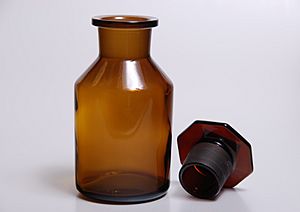Reagent bottle facts for kids
Reagent bottles are special containers used in laboratories. They hold different chemicals, either as liquids or powders. You might also hear them called media bottles or graduated bottles. These bottles are usually made of glass, plastic, or strong types of glass like borosilicate. They always have special caps or stoppers to keep the chemicals safe inside.
You'll find these bottles stored in cabinets or on shelves in labs. They are a very important type of laboratory glassware. The word "reagent" means a substance used in a chemical reaction. "Media" refers to the liquid or gas where a reaction happens.
Contents
Why Reagent Bottles Are Special
Protecting Chemicals from Light
Some reagent bottles are colored to protect the chemicals inside. For example, you might see bottles that are amber, brown, or red. These colors block out visible light, ultraviolet light, and infrared light. This is important because some chemicals can change or spoil if too much light touches them. In the past, some bottles were also tinted blue or green for decoration, especially in old pharmacies.
Measuring with Graduated Bottles
When a bottle is called "graduated," it means it has lines or marks on its side. These marks help you see about how much liquid is inside. It's like a measuring cup, but for lab use. The measurements are usually approximate, meaning they are close but not perfectly exact.
Common Sizes and Makers
Reagent bottles come in many sizes. The most common ones are 100 ml, 250 ml, 500 ml, 1000 ml (which is 1 liter), and 2000 ml (2 liters). Smaller bottles, even under 100 ml, were often used for expensive chemicals or in old medical settings. Many companies make these bottles, including well-known names like Wheaton, Kimble, Corning, and Schott AG. You might also see brand names like Pyrex or Kimax.
Caps and Stoppers
Choosing the Right Cap
The caps and stoppers for reagent bottles are just as important as the bottle material itself. The type of cap used depends on what chemical is stored inside. It also depends on how much heat the cap needs to handle. Common cap sizes include 33mm, 38mm, and 45mm.
Some bottles have narrow openings, while others have wide ones. Sometimes, you need a funnel to pour liquids into a reagent bottle without spilling. Many reagent bottle caps are "autoclavable." This means they can be heated to very high temperatures to kill germs, which is important for keeping lab work clean and safe.
Old Bottles and Glass Stoppers
Older or antique reagent bottles often look like classic pharmacy bottles. They usually have a glass stopper instead of a screw-on cap. These glass stoppers often weren't made to a standard size. This means if an old glass stopper gets lost, it can be very hard to replace. You might even need someone who works with glass to make a new one!
Safety and Standards
Reagent bottles are used in important scientific work. Because of this, they must follow strict rules and meet global scientific standards. This helps make sure they are safe and reliable for storing chemicals.
See also
References


